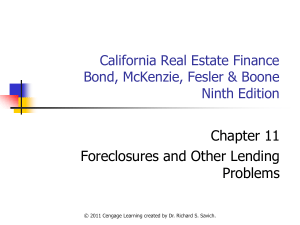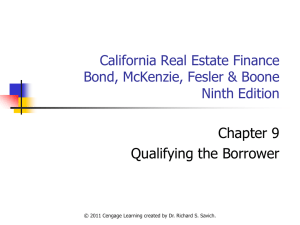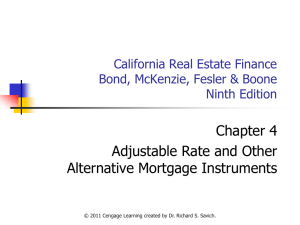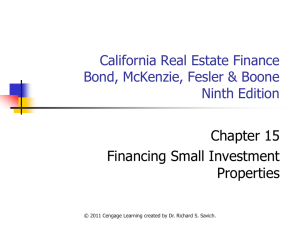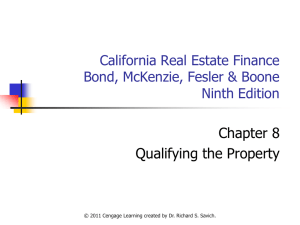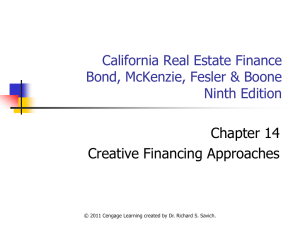California State University San Bernardino School of Business and
advertisement
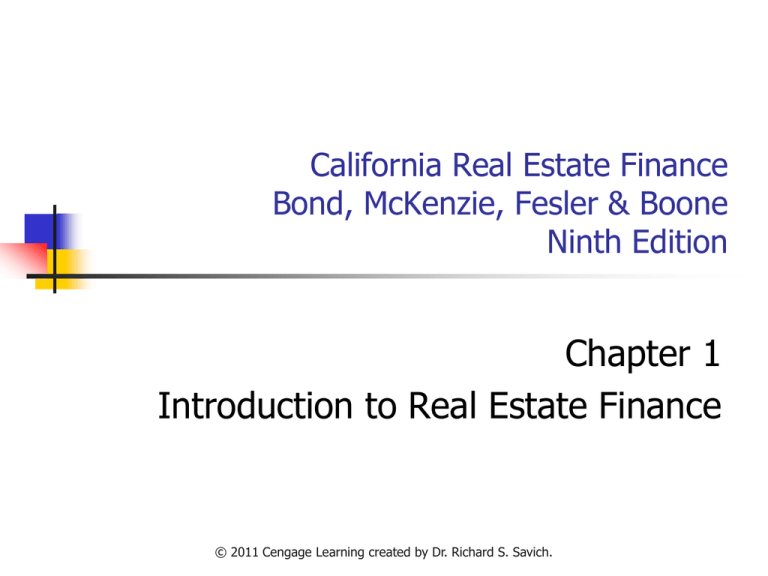
California Real Estate Finance Bond, McKenzie, Fesler & Boone Ninth Edition Chapter 1 Introduction to Real Estate Finance © 2011 Cengage Learning created by Dr. Richard S. Savich. Objectives After completing this chapter, you should be able to: Describe current financing trends in the real estate market. Trace the flow of money and credit into the mortgage market. Discuss the role of the Federal Reserve System. List five characteristics of the California mortgage market. Explain and illustrate two basic types of promissory notes. Describe the differences among a deed of trust, mortgage, and installment sales contract. © 2011 Cengage Learning created by Dr. Richard S. Savich. Outline Welcome to the Real World of Real Estate Finance Short Overview of the Mortgage Market The Meaning of Money The Flow of Money and Credit into the Mortgage Market Federal Control of the Money Supply Cost Characteristics of the Mortgage Market Instruments of Real Estate Finance The Five-Step Financing Process © 2011 Cengage Learning created by Dr. Richard S. Savich. Welcome to the Real World of Real Estate Finance Real Estate market in California Booms Busts (High interest rates, government deficits, better investment opportunities) Early 1960s 1971 – 1973 1975 – 1979 1982 – 1989 2000 – 2006 1966 1969 1974 1980 – 1981 1990 – 1996 2007 -- ???? Caused by disintermediation flow of money out of thrift institutions into the general money market © 2011 Cengage Learning created by Dr. Richard S. Savich. “Fog a Mirror” loans Interest only Stated Income 100% Loans Negatively Amortized Adjustable Rate Mortgage (Option ARM) © 2011 Cengage Learning created by Dr. Richard S. Savich. Money is… Money Near money Coins Paper currency Checking accounts (demand deposits) (along with debit cards) Negotiable orders of withdrawal (NOW accounts) Money market accounts Savings accounts (time deposits) U.S. government bonds Cash value of life insurance Preferred and common stocks publicly traded Money market mutual funds Credit Credit cards Overdrafts Credit reserves Home equity lines of credit © 2011 Cengage Learning created by Dr. Richard S. Savich. The Meaning of Money Created Accumulated Cash Checking Accounts Wages, fees & commissions Interest Dividends Profits Rents Ultimate source of funds for borrowing is savings © 2011 Cengage Learning created by Dr. Richard S. Savich. The Flow of Money and Credit into the Mortgage Market Income is Taxed Spent Saved Savings go to financial institutions Known as intermediation Withdrawals from savings are known as disintermediation Re-deposits are known as re-intermediation © 2011 Cengage Learning created by Dr. Richard S. Savich. © 2011 Cengage Learning created by Dr. Richard S. Savich. Federal Control of the Money Supply (Slide 1 of 2) Federal Reserve System Issues currency Monetary policy Reserve requirements A 20% reserve requirement means that $200 in reserves is needed for every $1,000 of deposits The higher the requirement, the lower the lending Fed buys and sells government securities The more government securities sold, the lower the lending Rate the Fed charges banks The higher the rate, the lower the lending Federal funds rate Open-Market operations Discount rates Bank to bank borrowing rate The higher the rate, the lower the lending Prime rate Rate banks charge preferred customers © 2011 Cengage Learning created by Dr. Richard S. Savich. © 2011 Cengage Learning created by Dr. Richard S. Savich. Federal Control of the Money Supply (Slide 2 of 2) U.S. Treasury Government Spending Government Taxing Together known as Fiscal Policy When spending exceeds taxing, inflation results Housing prices rise Fewer people can afford housing Established and promoted Federal National Mortgage Association (Fannie Mae) Government National Mortgage Association (Ginnie Mae) Federal Land Bank System “Recovery Act” 2008 “Make Home Affordable” program 2009 © 2011 Cengage Learning created by Dr. Richard S. Savich. Cost Characteristics of the Mortgage Market (Slide 1 of 3) Deposit cost (Interest paid) Borrowing costs (Underwriting and float) Sales costs (Promotion costs) Administration (Rent, utilities, etc.) Reserves (?%) Liquidity (Capital requirements) Profit (for the shareholders) © 2011 Cengage Learning created by Dr. Richard S. Savich. Cost Characteristics of the Mortgage Market (Slide 2 of 3) Interest rate changes due to Excessive government spending Large government borrowings Inflation Supply Demand Federal reserve actions © 2011 Cengage Learning created by Dr. Richard S. Savich. Cost Characteristics of the Mortgage Market (Slide 3 of 3) California Mortgage Market Large population and high demand Financial institutions Loan correspondents Title companies Security (Deed of trust) Active secondary market Diversification © 2011 Cengage Learning created by Dr. Richard S. Savich. Instruments of Real Estate Finance (Slide 1 of 2) Promissory notes Straight Installment Both principal and interest Balloon payments Interest only Both principal and interest, but principal payments not large enough, so more is due at end of note Negatively amortized Payments not even enough to cover interest © 2011 Cengage Learning created by Dr. Richard S. Savich. Instruments of Real Estate Finance (Slide 2 of 2) Deed of Trust (used in California instead of a mortgage) Borrower – Trustor Lender – Beneficiary Third party – Trustee (Holds title until loan is paid in full) Installment Sales Contracts Title remains with seller Seller is “lender” © 2011 Cengage Learning created by Dr. Richard S. Savich. © 2011 Cengage Learning created by Dr. Richard S. Savich. The Five-Step Financing Process Application (Chapter 10) Analysis/Processing (Chapters 8 & 9) Qualifying/Underwriting (Chapters 7 – 10) Funding/Closing (Chapter 10) Servicing (Chapters 10 & 11) © 2011 Cengage Learning created by Dr. Richard S. Savich. Questions and Comments? © 2011 Cengage Learning created by Dr. Richard S. Savich.
